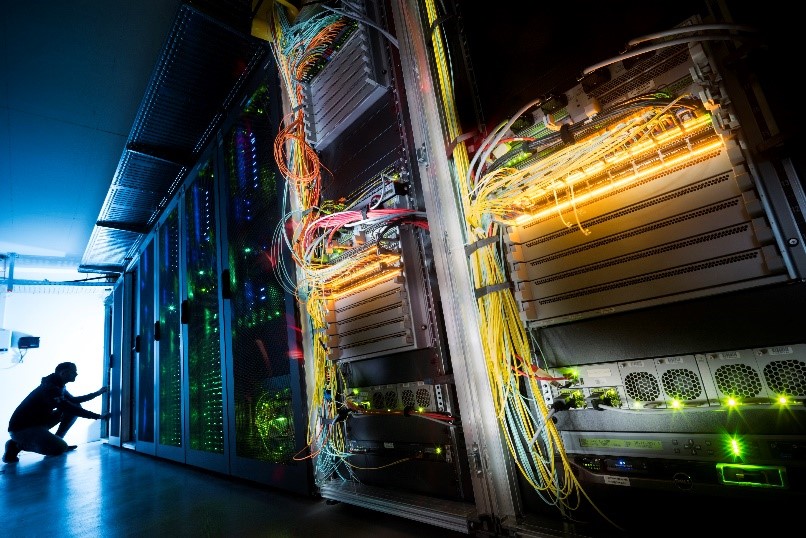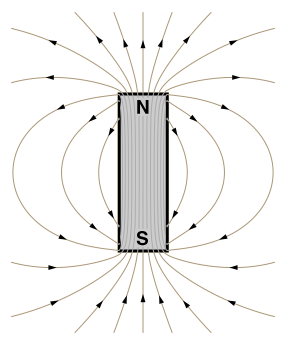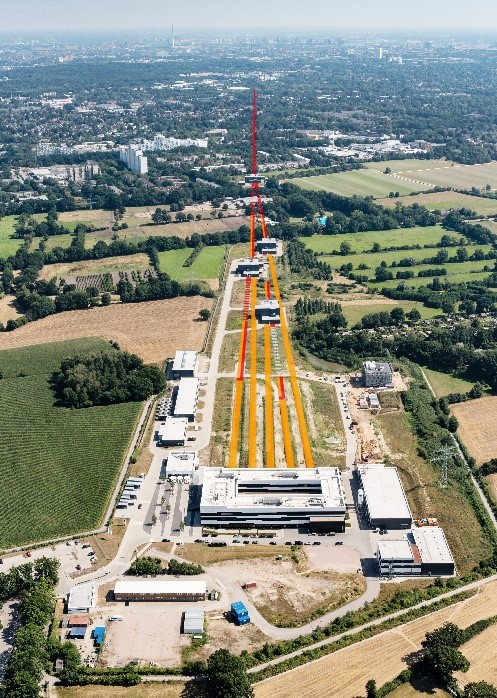Supporting materials
Download
Download this article as a PDF

When you snap a selfie or film a video for social media, where does that information go? Find out how magnetic ‘storms’ could help us achieve better, faster data storage.
Every time you snap a photograph for Instagram or save your favourite video game, the information that you have generated has to be stored somewhere. With a population of eight billion people, all of whom are increasingly reliant on digital technologies, the amount of data we produce is growing! But where and how does this data get stored?
The data we produce is stored on desktop computers, laptops, and our smart phones, as well as on devices such as solid-state disk drives (SDDs), hard-disk drives (HDDs), or flash memory. These devices can be expensive, use energy, and take up space. “Hold on a minute,” you may say, “data can also be stored in the cloud, and that doesn’t require any space!” Although cloud-based storage doesn’t take up any room in your house, cloud storage devices are still based on physical computer servers, albeit ones that are distributed in a network of locations around the world.

All data in your computer is stored as a number, and all information can be converted into a numerical form. Take, for example, the alphabet. If you assign a number to every letter in the alphabet, and also assign numbers to spaces and punctuation, then you can easily write text with numbers. A similar process can be applied to colours in a photograph. More complicated pieces of information, like high-resolution videos, are data-rich and take up more storage space.
Binary numbers are used to encode information. This is because binary numbers are formed purely of 1s and 0s, which can represent the states ‘on’ (1, or ‘true’) and ‘off’ (0, or ‘false’) in an electrical circuit. On/off systems are simple and easy to set up. Although binary numbers are formed purely of 1s and 0s, they can be used to represent any numerical value. Computer scientists call pieces of information written in binary format ‘bits’. Combinations of bits give rise to packets of data, with the most common type of packet consisting of eight bits. This is known as a ‘byte’.
More information takes more data storage space. More information can mean more words or numbers in a text file, or for images it can mean higher resolution or information about colour (or both). Video requires even more information (think of it as a series of pictures in a flipbook), and the higher the number of pixels and the greater the number of colours, the more storage space it needs. Let’s look at an example. Imagine a very crude circle drawn in an 8×8 grid.

If each square is a bit, then each line would be a byte. If a blank square was 0 (or off) and a black square was 1 (or on), then you could code the first line as 00011000, the second line as 00100100, and so on. You could string all of these together to get the binary code of a circle in an 8×8 grid and it would look like this:
000110000010010001000010100000011000000101000100010010000011000
You could send this code to a computer that knew the “rules” you were using to make the string of code (i.e. 8 rows of 8 bits), and it could draw the circle. In a gif, a jpeg, or a png file there is information at the start of the file that tells the computer what rules to follow, and it doesn’t have to be told ALL of the rules for that file if it’s told what file type it is and it already knows the basic rules for that type of file.
But this is a very crude circle – and it took 64 bits of information. What if you wanted a smoother circle? Or colour? You’d have to have either a bigger grid or more bits being interpreted as a smaller visual space. Or both. Even a circle in a 16×16 grid would look pretty rough (go ahead, try making one) and it would take four times as many bits as the 8×8 grid. A 32×32 grid would be 16 times bigger. Add in information about the colour of each grid box to make a coloured circle and it’s easy to see how fast the size of an image of just a circle could increase. Now imagine the size of files needed for a 4k resolution television. This is why we need hard drives that are more efficient at storing information.
Once information has been transformed into bits and bytes, it is saved to a data-storage device. By using only 1s and 0s, you can tell a machine that something is on/true (1) or off/false (0). The storage device physically changes in some way to record the information as a series of true and false values.
Storage solutions such as HDDs or floppy disks use magnetic materials to store data, and have done since the 1980s. Magnetic materials can attract and repel one another through magnetic fields, patterns that describe the directions of the magnetic push and pull in a magnet. By using other magnets or electricity, the pattern of a magnetic field can be changed in certain materials to reflect a pattern of 0s and 1s, and this gives rise to data storage. Limitations arise from how quickly you can change the pattern (tell the material binary numbers, that is, ‘write’ the data) and how quickly you can determine what those changes are (‘read’ the data).

Newer data-storage materials, such as those in your phones, laptops, and USB drives, use flash storage that is based on electrical charges instead of magnetic field patterns.
As we come to rely more on data, we need data storage solutions that are:
Scientists around the world are looking for new methods of storing data that are faster and more energy efficient. To do this, they’re returning to magnetic materials and investigating an exciting type of magnetic structure known as a ‘skyrmion’.
So, what is a skyrmion? First conceived by British physicist Tony Skyrme in the 1960s, skyrmions are tiny magnetic storms that exist in the structures of magnets on atomic scales. You can think of them as resembling a very small spiral in the magnetic field. They can exist on their own, or in regular patterns known as lattices. These complicated miniature structures are extremely stable and require little energy to create or erase. This makes them an attractive candidate for smaller, more energy-efficient storage materials.
Although they don’t know how yet, scientists are convinced that they will one day be able to save information to media by using skyrmions and be able to read it back. Some studies suggest that creating and erasing skyrmions as a method of data storage could be almost 10 000 times more energy efficient than current devices.[1] Under the right conditions, scientists can use short bursts of light from a laser to create skyrmions in magnetic materials. But although these skyrmions can be generated, controlling and understanding their behaviour, and discovering how they can be adapted for data storage, is no easy task.

An X-ray free electron laser (XFEL) can generate short bursts of X-ray radiation. These bursts of X-ray radiation are just a few tens of femtoseconds long. A femtosecond is one quadrillionth of a second long, or 1×10−15 seconds long (see the Timescale Infosheet in the supporting material). To put this in context, one femtosecond is to ten seconds, what ten seconds are to the lifetime of the universe (13.6 billion years). By using these extremely short bursts of radiation, scientists can observe the behaviour of skyrmions.
An experiment to investigate this phenomenon is being undertaken at the European XFEL, one of the world’s most powerful X-ray lasers, in Hamburg, Germany.
The European XFEL is an X-ray free-electron laser that generates extremely short, bright flashes of X-ray radiation about 27 000 times a second. The European XFEL is located in Hamburg, Germany, and is housed in underground tunnels that cover a distance of 3.4 km. To generate the X-ray radiation, electrons are first accelerated to almost the speed of light. After they have raced 1.7 km through the accelerator, the electrons pass into structures called ‘undulators’. These are a series of alternating magnets that force the electrons to go on a tight slalom course. When electrons are sent on a curved path by strong magnets like this, they emit X-rays that resemble laser light. Scientists from across the world come to the European XFEL to use these X-ray flashes for their research.

Scientists can use the European XFEL’s powerful X-ray laser beam, along withstate-of-the-art diagnostic techniques, to understand the behaviour of skyrmions. At European XFEL’s Spectroscopy and Coherent Scattering (SCS) instrument, scientists use an infrared laser beam to generate a skyrmion in a thin film of magnetic material, while simultaneously monitoring the process by using the X-ray beam. This allows them to monitor the formation of a skyrmion in a controlled manner.
By using the ultra-sensitive detectors and powerful X-ray beam at the European XFEL, researchers have been able to make new discoveries about the nature of skyrmions, showing that they can be created very quickly (in less than 300 ps) and in large quantities.[2, 3] This is vital for their use in reliable data storage.

This characterization pushes forward our basic understanding of magnetic phenomena, such as skyrmions. In other words, it tells us about fundamental physics, or the underlying nature of things. Developing our understanding of fundamental physics then enables engineers and companies to drive innovation, and improve technology for all of us. Though skyrmions may still have some way to go, these exciting magnetic whirlpools may yet revolutionise data storage!
[1] An article on controlling skyrmions with lasers on the EPFL website: https://actu.epfl.ch/news/controlling-skyrmions-with-lasers/
[2] Büttner F et al. (2021) Observation of fluctuation-mediated picosecond nucleation of a topological phase. Nature Materials 20: 30–37
[3] An article about controlling magnetic swirls in the European XFEL news: https://www.xfel.eu/news_and_events/news/index_eng.html?openDirectAnchor=1825
Download this article as a PDF